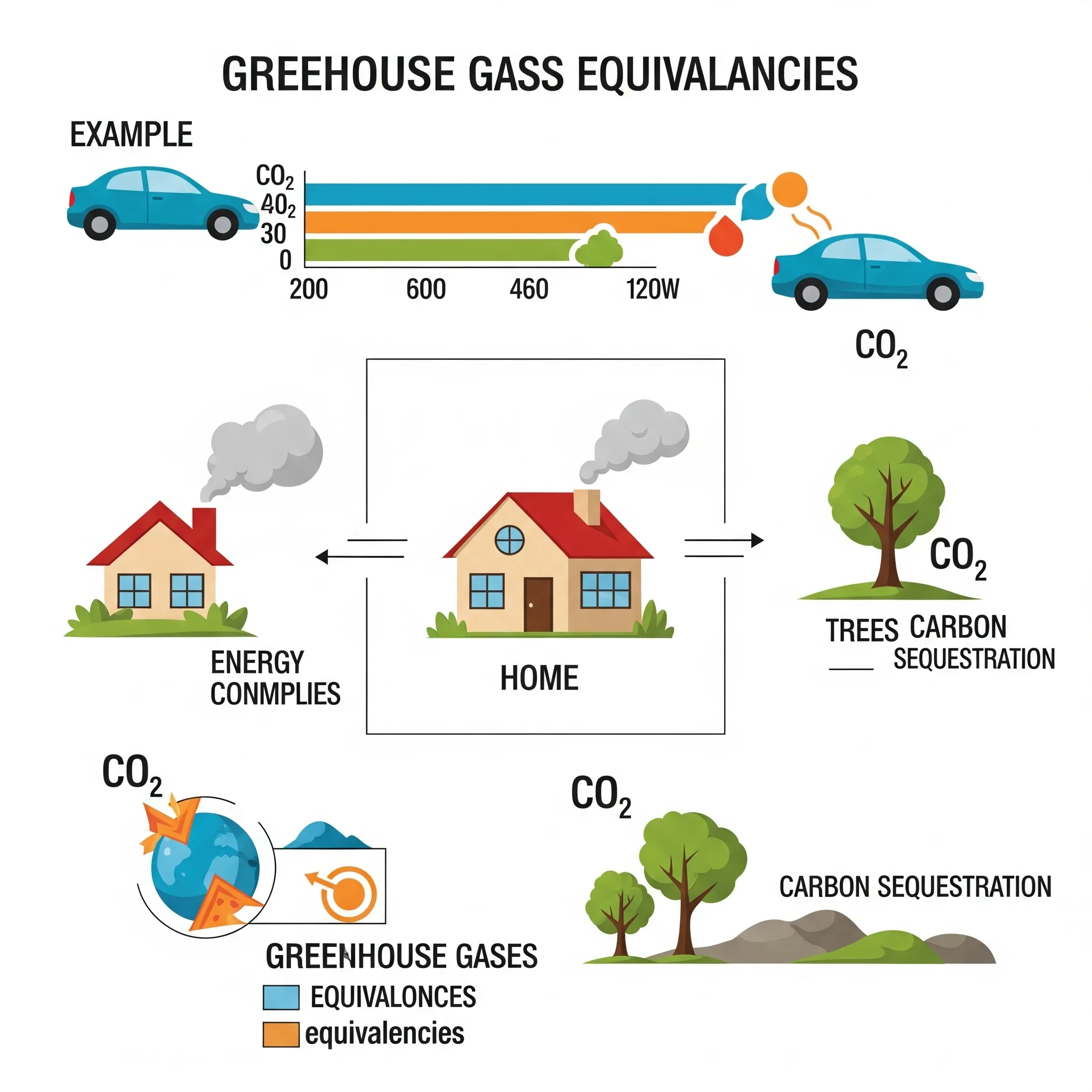Greenhouse Gas Equivalencies Calculator: Understanding Your 2025 Impact
We often hear about carbon footprints and greenhouse gas emissions, but what do those large, abstract numbers actually mean for our daily lives and the planet? As EcoDwellers striving for a more sustainable future, understanding our individual and collective impact is crucial. This is where a Greenhouse Gas (GHG) Equivalencies Calculator comes in – a powerful tool that translates complex emissions data into tangible, relatable comparisons. My own green journey has taught me the importance of such tools in making informed choices. In this guide, we’ll explore how to use a GHG equivalencies calculator in 2025 to better grasp your environmental footprint and discover actionable ways to reduce it.

What Exactly is a Greenhouse Gas Equivalencies Calculator?
A Greenhouse Gas (GHG) Equivalencies Calculator is an online tool designed to help you understand the scale of greenhouse gas emissions by converting them into everyday terms. Instead of just seeing a figure in “metric tons of CO2 equivalent (MTCO2e),” a calculator might tell you this is comparable to the annual emissions from a certain number of cars, the energy used by several homes, or the carbon sequestered by a specific acreage of forest. The primary GHGs include Carbon Dioxide (CO2), Methane (CH4), and Nitrous Oxide (N2O), each with different global warming potentials.
These calculators use standardized conversion factors, often provided by governmental agencies like the U.S. Environmental Protection Agency (EPA), to provide these understandable comparisons. This makes the concept of emissions much less abstract and more actionable for individuals and organizations alike.
Why Use a Greenhouse Gas Equivalencies Calculator in 2025?
In 2025, as the urgency of climate action grows, understanding our contribution is more important than ever. Using a GHG equivalencies calculator, specifically a Greenhouse Gas Equivalencies Calculator, offers several benefits:
- Enhanced Understanding: It makes abstract data concrete and relatable.
- Identifies Impact Areas: Helps pinpoint which activities contribute most to your emissions.
- Motivates Change: Seeing equivalencies (e.g., “my annual commute equals X trees needed to offset”) can be a powerful motivator for adopting more sustainable practices.
- Effective Communication: Allows you to share your impact or reduction efforts in terms others can easily grasp.
- Supports Informed Decisions: Whether for personal lifestyle changes or business strategies, it provides a clearer picture.
This aligns perfectly with The EcoDweller’s Guide to Sustainable Living, which emphasizes conscious choices and understanding our environmental roles.
- Translates complex data into understandable metrics.
- Empowers individuals to make targeted changes.
- Aids in setting realistic reduction goals.
- Promotes environmental literacy and awareness.
How to Use a Greenhouse Gas Equivalencies Calculator: Step-by-Step
Using these calculators is generally straightforward. Here’s a typical process for any Greenhouse Gas Equivalencies Calculator:
Step 1: Find a Reliable Calculator
Several reputable organizations offer free GHG equivalencies calculators. A widely used one is the EPA’s Greenhouse Gas Equivalencies Calculator. Many others exist, often focusing on specific activities or regions.
(Note: The EPA’s calculator is excellent for converting existing emissions data into equivalencies. For calculating your *initial* footprint, you might use a carbon footprint calculator first, then use the EPA’s tool for equivalencies.)
Step 2: Gather Your Emissions Data (If Applicable)
Some equivalency calculators allow you to input a known quantity of emissions (e.g., from a personal carbon footprint calculation, your company’s emissions report, or the impact of a specific project). If you don’t have this, many carbon footprint calculators can help you estimate it based on your energy use, travel, waste, etc. Consider reviewing your DIY energy-saving efforts to see how they might reduce these inputs.
Step 3: Input the Data
Enter the amount of greenhouse gas emissions (usually in metric tons of CO2e) or the specific activity data (e.g., kilowatt-hours of electricity, gallons of gasoline) into the calculator.
Step 4: Explore the Equivalencies
The calculator will then provide a list of equivalencies. For example, 10 MTCO2e might be equivalent to:
- Emissions from 2.17 passenger vehicles driven for one year.
- CO2 emissions from 1,200 gallons of gasoline consumed.
- CO2 emissions from the energy use of 1.2 homes for one year.
- Carbon sequestered by 11.8 acres of U.S. forests in one year.
Step 5: Interpret and Act
Use these relatable figures from your Greenhouse Gas Equivalencies Calculator to understand your impact and identify areas where you can make changes. For instance, if your energy use equivalency is high, you might focus more on home energy efficiency.

Taking Action with Your Greenhouse Gas Equivalencies Calculator
The real power of a GHG equivalencies calculator lies in its ability to inspire action. Once you understand your impact in concrete terms from your Greenhouse Gas Equivalencies Calculator, you can focus your efforts:
- Reduce Home Energy Consumption: If your “homes’ energy use” equivalency is significant, explore options from simple easy sustainable swaps like LED lighting to larger projects like improving insulation or even considering DIY solar panel installation.
- Minimize Transportation Emissions: If “vehicles driven” is a big factor, consider public transport, cycling, walking, carpooling, or transitioning to an electric vehicle.
- Cut Down on Waste: Emissions from landfills (especially methane) are potent. Seeing this equivalency can motivate you to embrace zero waste principles, improve recycling, and start backyard composting.
- Make Conscious Consumer Choices: The products and food we consume have associated emissions. Opting for locally sourced, plant-rich diets and sustainable products can make a difference.
Broader Applications of Greenhouse Gas Equivalencies Calculators
Greenhouse Gas Equivalencies Calculators aren’t just for individuals. They are valuable for:
- Businesses: To communicate sustainability efforts and set reduction targets.
- Educators: To teach students about climate change in an engaging way.
- Policymakers: To illustrate the impact of different policies or projects.
- Community Groups: To raise awareness and mobilize local action using data from a GHG equivalencies calculator.
Where to Find Reputable Greenhouse Gas Equivalencies Calculators
| Calculator Name / Provider | Focus | Link |
|---|---|---|
| EPA Greenhouse Gas Equivalencies Calculator | Converts emissions data (MTCO2e) or energy consumption into various common equivalents. A leading Greenhouse Gas Equivalencies Calculator. | Visit EPA Calculator |
| CoolClimate Network (UC Berkeley) | Offers comprehensive carbon footprint calculators that can then be understood with equivalencies. | Visit CoolClimate |
| UN Carbon Footprint Calculator | Helps individuals estimate their footprint, which can then be conceptualized with equivalencies. | Visit UN Calculator |
Many other specific calculators exist for flights, events, or particular industries. Always check the source and methodology of any emissions impact tool or climate impact converter you use.
Make Your Impact Count (Positively!)
Understanding your greenhouse gas emissions through the lens of an equivalencies calculator is a vital step towards a more sustainable lifestyle in 2025. It transforms abstract numbers into meaningful insights, empowering you to make targeted changes that collectively contribute to a healthier planet. This journey of awareness and action is at the heart of being an EcoDweller.
Take some time this week to explore a Greenhouse Gas Equivalencies Calculator. What equivalency stands out to you? Share your thoughts and any actions you plan to take in the comments below! For more guidance on your green journey, check out our Eco Dweller Beginner Tips.
Try the EPA’s GHG Calculator Now
